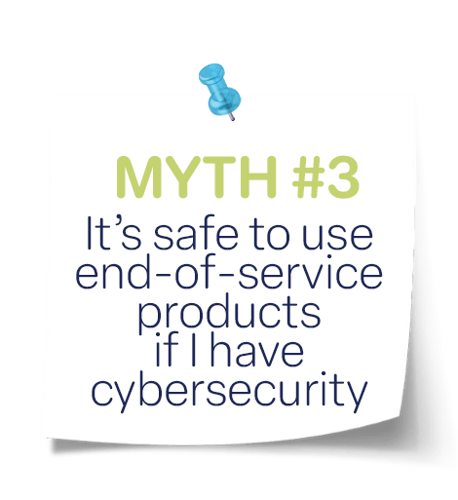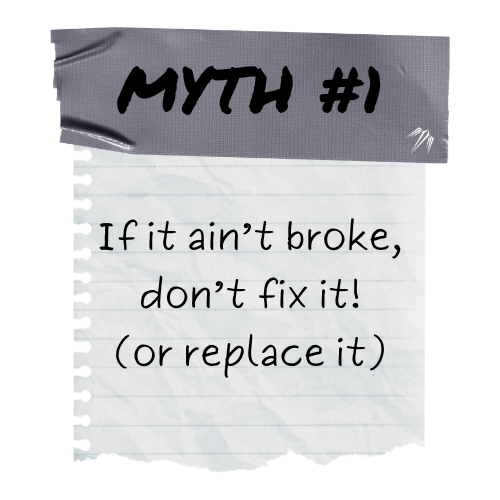In today's fast-paced digital landscape, it's no secret that technology evolves at an astonishing rate. What's "cutting-edge" today could easily become "outdated" tomorrow, and it's in this whirlwind of change that myths about end-of-life (EoL) or end-of-service (EoS) technology have taken root. These misconceptions often lead organizations down the wrong path, causing more harm than good.
If you've ever been tempted to delay replacing your aging technology to save time and money in the short run, you're not alone. But it's crucial to understand the potential consequences this can have on your organization's operations and reputation in the long term.
So, to clear the air and provide you with the insights you need, let's have a chat about three common myths surrounding end-of-life technology and how they might impact your organization.
The Hidden Costs of Delaying Tech Upgrades
The age-old saying "If it ain't broke, don't fix it" might apply to some things in life, but when it comes to technology, it can be a dangerous philosophy. Many believe that replacing technology is only necessary when it's malfunctioning, leading to the myth that if your devices are still running, there's no need to upgrade. However, this myth overlooks the hidden costs of delayed tech upgrades.
Diminished Performance: Older technology tends to lag behind in performance compared to newer counterparts. Slower processing speeds and outdated software can hinder productivity and frustrate employees. Tasks that should take minutes may stretch into hours, affecting your bottom line.
Compatibility Issues: As technology evolves, so do software and hardware standards. Older systems may struggle to run new applications or integrate with modern tools. This can result in compatibility issues, limiting your organization's ability to adopt innovative solutions.
Security Vulnerabilities: Perhaps the most critical aspect is security. Outdated technology often lacks essential security updates and patches. Cybercriminals actively target vulnerabilities in older systems, making them more susceptible to data breaches and cyberattacks. Delaying upgrades can expose your organization to significant risks and potential data breaches.
Costly Repairs: While you might save money by postponing upgrades in the short term, you could end up with higher costs in the long run. Maintenance and repairs for aging equipment can become increasingly expensive as replacement parts become scarce, leading to unexpected budget hits.
Proactive technology management is essential to keep your organization running efficiently and securely. It's not just about fixing what's broken; it's about preventing those breakdowns in the first place. By staying up-to-date with technology, you can ensure that your organization is equipped to tackle the challenges of the modern business landscape.

Understanding the True Meaning of End-of-Life
Many think that a product's end-of-life occurs when it's officially discontinued by the manufacturer. This notion is partially accurate but lacks a crucial understanding of what end-of-life genuinely entails in the world of technology.
While it's true that manufacturers may discontinue a product, the term "end-of-life" goes beyond discontinuation. It marks the point at which the manufacturer ceases to provide essential support, including software updates, security patches, and technical assistance. In other words, it's the moment when your trusty tech companion is left to fend for itself in an ever-evolving digital landscape.
Moreover, staying compliant with industry regulations can become a daunting task when using end-of-life products. Many compliance standards require up-to-date software and security measures. Ignoring end-of-life can lead to compliance violations and potential legal repercussions.
Instead of clinging to outdated technology, it's wise to embrace a proactive approach. Understand that end-of-life is a natural phase in a product's lifecycle. Plan your technology upgrades accordingly. This proactive stance ensures that your organization remains secure, compliant, and equipped with the latest features and improvements that can drive efficiency and innovation.
In summary, while discontinuation is a part of end-of-life, it's the lack of vital support that makes this phase critical. Embracing the reality of end-of-life and planning for tech upgrades is essential to safeguard your organization against security risks, maintain productivity, and stay compliant with industry regulations.

Cybersecurity Not Guaranteed
In an era where cybersecurity is a top concern for businesses, some may believe that robust cybersecurity measures can shield them from the vulnerabilities of EoS products. This is a common myth, but it's essential to understand that while cybersecurity is undoubtedly crucial, it's not a silver bullet that can protect outdated systems indefinitely.
Cyberattacks are growing more sophisticated by the day. Hackers actively seek out vulnerabilities in systems, and they're not picky about whether those systems are old or new. In fact, older systems that are no longer supported are a prime target for bad actors.
EoS products no longer receive critical security updates and patches from the manufacturer. This means that any new vulnerabilities or exploits discovered after the end-of-service date remain unaddressed. Cybercriminals are well aware of this and target such systems precisely because they know they're no longer receiving protection.
Using EoS products while relying solely on cybersecurity measures is similar to locking the front door while leaving the back door wide open. It creates a false sense of security that can lead to devastating consequences. A breach of an EoS system can result in data breaches, financial losses, legal liabilities, and reputational damage.
To ensure robust cybersecurity, it's crucial to take a holistic approach. This means not only having cybersecurity measures in place but also keeping your technology up-to-date. Timely upgrades are a critical part of your organization's overall security posture. They ensure that your systems remain resilient against both known and emerging threats.
Ascend Can Help
If you didn't before, you now understand the importance of keeping your software and hardware up-to-date to avoid unnecessary setbacks. Yet, going it alone in this tech-driven world can be a daunting task. That's where we come in – as your IT service provider, but more importantly, as a partner who understands your challenges.
Picture having a trusted ally beside you, providing essential guidance and expertise every step of the way. Together, we'll navigate the complexities of technology, ensuring your IT systems run smoothly and securely.
Your organization deserves the best, and we're here to make sure you get it. If you're eager to learn more, don't hesitate to reach out. Let's start a conversation that could transform your business and provide peace of mind on your journey.


